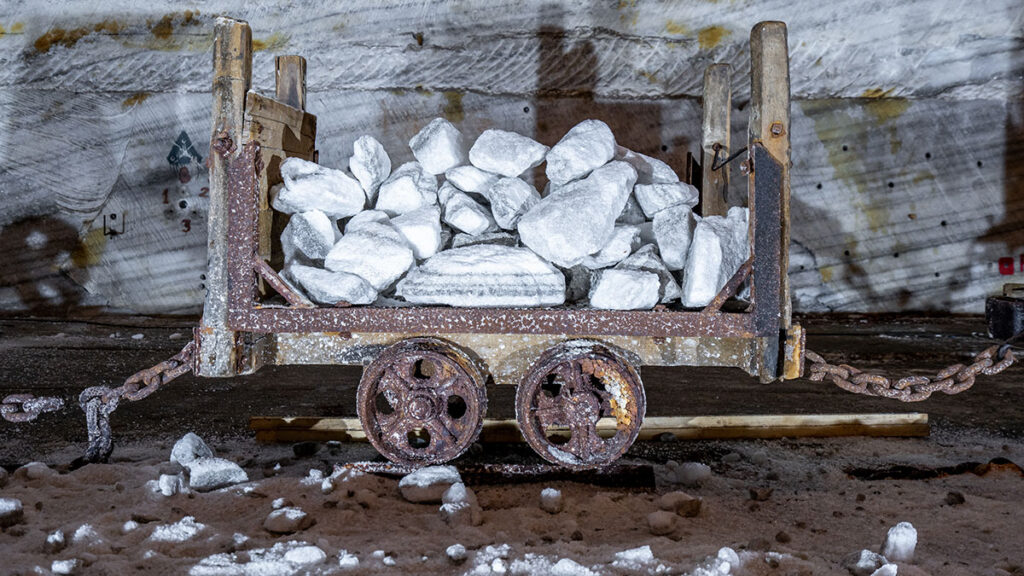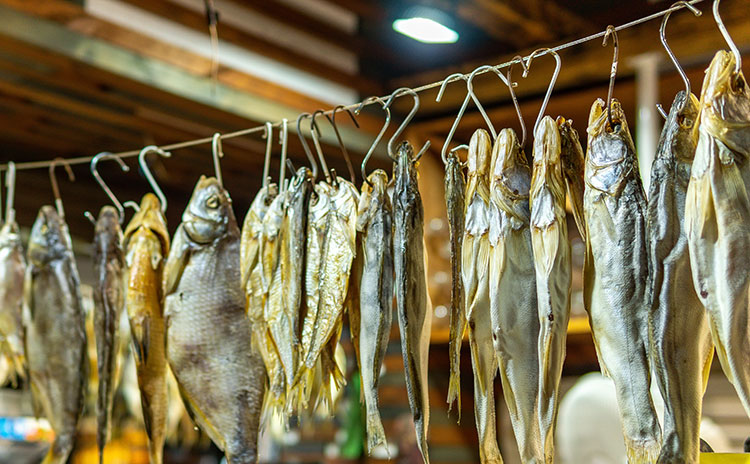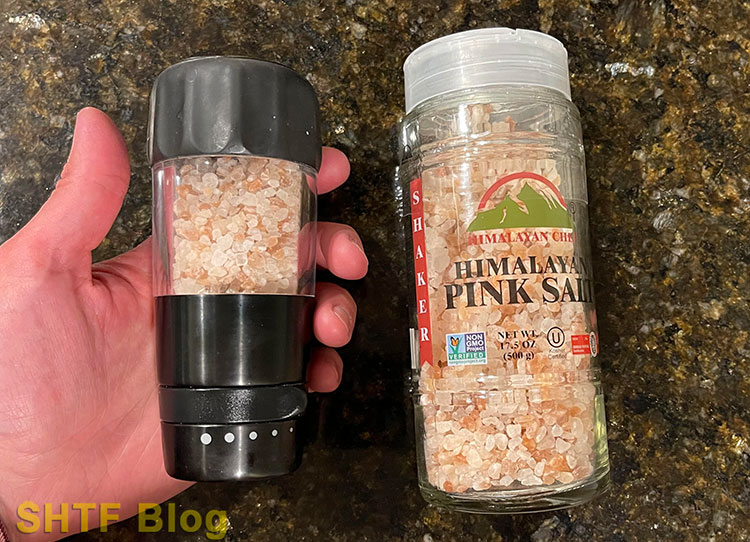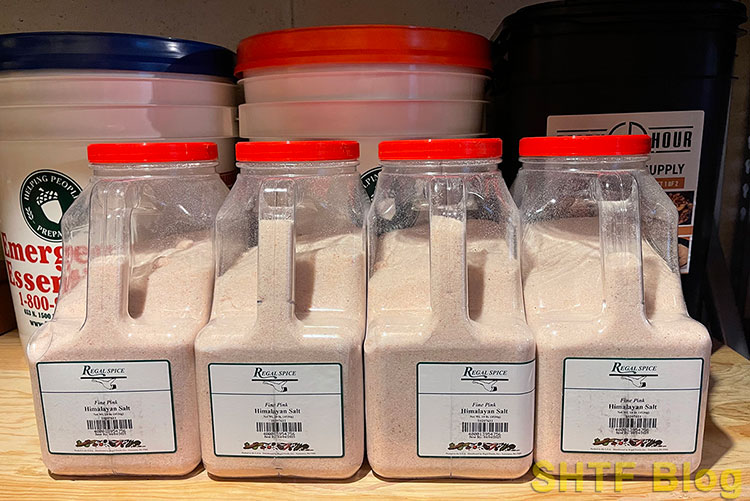
Salt is an important part of a prepper’s long-term food storage plan. Our bodies need salt to stay healthy and it’s a vital component to food preservation. Of course, we also want salt to flavor our food. Many foods would be dull without a dose of salt.
Fortunately, storing salt long-term is easy as the right salt stored under the right conditions will last indefinitely. This is not too different from storing peppercorns long-term. What’s more, modern mining and production methods have made salt plentiful and low-cost. This is in stark contrast to the history of salt, when it was both difficult to extract and expensive to buy.
Why Store Salt?
Preppers should store salt for its value as a seasoning, what it does for our health, and how it can be used for food preservation. Because it is so plentiful and low-cost, it’s also very easy to store in quantity, and quantity is what you would need in an extended crisis. Any surplus salt you have can be used for barter.
Seasoning
If you ask someone on the street what they use salt for, the most common answer is going to be to add flavor to food. Indeed, one good reason a prepper wants to store salt is to season food, and in a survival situation where you are eating a lot of stored rice and beans every day, salt will make eating those meals day in and day out a bit more palatable.
Health Uses
We also can’t discount the health benefits. Our bodies need salt. While it might sound counter-intuitive, salt helps keep us hydrated. It induces body water conservation. While the average American consumes too much salt, you are unlikely to face that problem in a survival situation. You’ll have the reverse problem—not enough salt.
Some of the health benefits of salt include:
- Helping you stay hydrated (water follows salt in the body).
- Helping prevent muscle cramps.
- Supporting the nervous system.
- Improving sleep.
Salt has actual medicinal uses as well. Because it draws moisture out of cells, it can kill different types of bacteria and fungi cells. When the grid goes down and access to modern health services are compromised, salt can offer some at-home remedies, treating many ailments such as canker sores, eczema, heartburn, insect bites, sore throats, and constipation (which could be a problem with eating some foods stored long-term).
Food Preservation
For the advanced prepper, you can also store salt to help you preserve even more food. According to the USDA:
Salt binds or removes water so that it does not enable the growth of microorganisms. It is a food additive that has been used for thousands of years. Until canning was invented, salt was a critical food preservation item. In colonial America, food preservation required 40 pounds of salt per person per year.
https://ask.usda.gov/s/article/How-is-salt-used-to-make-food-shelf-stable
Salt for food preservation is most commonly associated with meat. Because meat attracts bacteria, drawing the water out with salt means microbes cannot survive.

Naturally, with modern food practices, we don’t need that much salt today. However, in a survival situation, preserving meats with salt is neither difficult nor time-consuming, and simplicity is your friend with survival. The simple act of salting and brining wild game or farm animals will preserve the meat and help keep your family fed in a prolonged collapse.
How Was Salt Stored Historically?
Archeological evidence dating back to the Bronze Age shows man using salt. If societies knew the value of salt in the Bronze Age (and likely before that), we should appreciate it still today.
Throughout history, salt has always been a valuable commodity. Wars have been fought over the over the control of salt reserves. The process of getting salt was one reason it was so expensive. You either boiled it or mined it. Ancient Britons had to extract it from seawater. These processes were not easy to do.

Salt was often stored as a brick and shaved or cut off as needed. In some cases, it was stored in a crock for transit. Occasionally, it was stored in barrels; though only the rich could afford enough salt to fill a barrel.
How Long Can You Store Salt?
Pure salt will last indefinitely if stored in the right conditions. It is a stable compound, so it will not break down easily. This also means it will retain its flavor indefinitely.
Flavored or iodized salt has a shorter shelf life due to the additives used to make it.
There are some caveats to indefinite storage, however. Bugs or mice can get into the cardboard packaging. Moisture is also an enemy.
Types of Salt to Store
You might think that salt is salt, but that’s not true. Certain types of salt are better-suited to long-term storage in the prepper’s pantry than others, but in all likelihood you’ll want a variety.
The four most common types of salt include:
- Table Salt
- Sea Salt
- Pink Himalayan Salt
- Curing Salt
- Pickling Salt
Table Salt
Table salt, the salt we commonly reach for at dinner, is refined and heavily processed. Minerals are removed in the refining process and potassium iodide is added with a small amount of sugar to prevent the iodine from turning yellow. The process of iodizing it began in 1924 and became more universal in the 1980s in order to help prevent iodine deficiencies. Addressing iodine deficiency reduced incidences of serious birth defects. Iodine deficiency is the most common preventable cause of mental retardation.
Despite the benefits of iodization, table salt only has a shelf-life of about 5 years. That is far from the indefinite period you’ll find with other salts. Given my interest in incorporating “set it and forget” long-term foods, table salt has a lower priority in my food storage. However, it does have its place and some amount of it should be stored. The benefit of iodine is real, and it will become even more real in a collapse.
Table salt, despite its shorter shelf-life, is worth storing. Rotate stock as you use it for everyday use and don’t buy more than you can rotate through every five years. Then you’ll never find yourself with “bad” table salt.
Sea Salt
Sea salt contains sodium chloride and other naturally-occurring minerals. It is made from evaporating sea water, but there are many varieties of it. There is smoked sea salt, Hawaiian sea salt, Fleur de Sel, Celtic salt, and flake salt. Not all these types of salt are for use at the table. Pure sea salt has an indefinite shelf life. It is great all-purpose salt for long-term storage, but it can cost more than other types of salt.
Pink Himalayan Salt
Himalayan pink salt gets its name from its color and the area where it’s mined. It contains a high percentage of sodium chloride, but it is the combination of potassium, magnesium, calcium, copper, and iron that gives it a pink color. It comes from the Khewra Salt Mine near the Himalayas in Pakistan, the world’s second largest salt mine said to have been discovered by Alexander the Great’s horse.

- 100% Pure & Natural Himalayan Salt
- Food Grade & Certified Kosher
- Certified Authentic
- Rich in Trace Minerals - including Calcium, Magnesium, Potassium, Copper and Iron
- Season meats, grilled vegetables, a variety of salads, soups & stews or use when baking.
Himalayan pink salt is one of the best salts for preppers to store for the long-term. Its intense flavor means you don’t need as much salt as you usually would to season food, allowing you to get more flavor for the amount stored. While it lacks the iodine of table salt, it provides other ingredients integral to our health that table salt does not. Its potassium content in particular offers a better balance to the sodium, as both are important electrolytes to maintain fluid and blood volume.
Curing Salt
Curing salt contains nitrates/nitrites, though exact ingredients depend on the brand you buy. This is the ideal salt for preserving meat as it is particularly good at drawing the moisture out of the meat to prevent bacteria and fungus from growing. Pink curing salt will give the meat the red or pink color that we are accustomed to seeing.
Despite its beneficial use as a preservative, it should not be used at the dinner table. It adds too many preservatives.
- Pink Salt #1 - Batch Tested and Verified Gluten Free
- Perfect for wet-curing/preserving sausages, white fish, ham, salami's, all types of bacon and more!
- Enough to cure hundreds of pounds of meat
- Generally used to wet-cure meat that requires cooking before consumption
If the brand of curing salt you use is just salt and sodium nitrate/nitrite, it has an indefinite shelf life. If your curing salt has artificial flavors such as propylene glycol or fat stabilizers, use the expiration date on the package.
If you want the ability to cure meat as part of your personal preparedness plan, then you want to store enough curing salt to meet your situation and needs.
Pickling Salt
Pickling salt, also known as canning salt, does not contain nitrates/nitrites. It is more fine than other salts so that it can dissolve more quickly into a brine solution for pickling.
- Pack of two, 4-pounds per unit (total of 8 pounds)
- A pure granulated salt, with no added preservatives or free-flowing agents
- Can be used in cooking, canning and pickling
Don’t overlook pickling salt in your preparedness plan. It is a pure salt without iodine or other additives. A choice for canning enthusiasts for years due mainly to the clear brine produced when granules are dissolved. It does not cause canned items to turn colors. It can also be used for salt-cured ham or sausage. Its shelf life is indefinite.
Rock Salt
Rock salt is not food-grade salt, but it does have uses, and it can be stored indefinitely. The main use of it is for deicing roads and walkways, but it can also have an indirect use for food, mainly through assisting ice to keep foods cold. Salt lowers the melting point of water, so water that has salt in it will get colder faster than water without salt in it.
Unless you have grand plans of making a lot of ice cream after the apocalypse (rock salt helps by keeping the ice cream container cold during the production process, I would not bother to store much of it. It’s more important to focus on salt that can actually be consumed.
3 Steps to Storing Salt Like a Prepper
Storing salt properly involves more than just throwing a couple of saltshakers in the basement. The best way to store salt long-term is to choose pink Himalayan or sea salt and store it in a sturdy, food-safe container in a cool, dry place. It is one of the simplest foods to store. You do not need a vacuum sealer, dehydrator, or freeze-dryer.

In the photo above you see my 40 pounds of stored salt. Because these were shipped in convenient food-grade plastic containers, 10 pounds per container, and I have a cool, dark storage room, no additional methods are needed for long-term storage. Easy!
1 – Choose Your Salt(s)
Diversity is the spice of life – no pun intended. Where different salts have different purposes, you will probably want to store a few different kinds depending on your intended uses and needs after a collapse. My favorite, all-purpose salt to store indefinitely is pink Himalayan salt.
I compared prices of pink Himalayan salt between a few different online retailers: WebstaurantStore, Salt Works, Bulk Apothecary, and Amazon. At that time, WebstaurantStore had the best pricing. Amazon may have been more competitive, but bulk quantities were out of stock at the time I ordered.
I bought 40 pounds of fine grain pink Himalayan salt for $77.33 with shipping. That would easily cover a family of four for an entire year. Not bad!
2 – Choose the Right Containers
Salt is often packaged in cardboard boxes or plastic bags, but these aren’t going to work for the long-term. Cardboard absorbs moisture and offers little protection against bugs or mice.
Salt can be stored in air-tight plastic containers, food-grade plastic buckets with proper lids, Mylar bags, or Mason jars. Air-tight containers are good for regular kitchen use. Mylar bags will keep light and bugs out, but they can be torn. Mason jars will work, but they’re prone to breaking and they do not block light.
I prefer a combination of Mylar bags and food-grade plastic buckets for long-term storage. The Mylar bags are ideal for food storage as they can be sealed air-tight, and they block moister and light. Plastic buckets offer a strong protective shell, they keep rodents out, and you can stack them.
You don’t have to be this redundant, however. You can store the salt in heavy-duty Ziploc bags inside a food-grade plastic bucket. Food-grade quality plastic means chemicals won’t leach from the plastic into your salt.
- Pack of 4 Green Buckets with White Lids
- These Buckets are Food grade- BPA Free- Made in USA
- They are sturdy and stack well. Features a tapered design which allows empty buckets to nest and separate easily.
- Containers come with Air-Tight screw on lids that allows easy access to your stored goods.
- Buckets are great for storing dry food like beans, rice, flour, sugar, salt, pasta. Honey. Pet food. Livestock feed. Birdseed.
Smaller containers are better than larger containers. You use salt in small amounts, and salt is heavy. One gallon of salt weighs about 9.625 pounds. That means a five-gallon bucket full of salt would weigh a whopping 48.125 pounds. Two-gallon buckets may be ideal for salt storage.
Do not use metal containers to store salt. Because salt is corrosive and absorbs water, it can cause metal containers to rust which will then contaminate the salt.
3 – Choose the Right Conditions
Again, a cool, dark place with (relatively) consistent temperatures is ideal for storing salt. I store my salt in a dry basement.
Additional Storage Notes
Despite our best efforts, accidents happen. Stored salt that has become wet or was exposed to humidity can be dried out. It can be spread out across a baking sheet and set in the oven at a low temperature (below 200 degrees F). Stir it occasionally to break up clumps. If baking is not an option, spreading it out in the sun on a hot day can also work.
Do not use oxygen absorbers when storing salt. They’re recommended for storing many other types of food but removing oxygen from salt with cause it harden into a brick. This will not ruin the salt, as we noted it was once stored this way, but it does then require smashing it apart for use. The oxygen absorbers are simply unnecessary. They will cost you money and just harden the salt.
Hardened chunks of salt can be broken apart with a clean hammer or meat tenderizer. Place it in a strong plastic bag to break it apart. When it breaks into smaller chunks you can place it in a bowl and pulverize it by pressing it with a large spoon.
If you’re planning to do a lot of cooking after the apocalypse, you’ll also want to know how to store flour and how to store sugar. Then you’ll have a good foundation of the ingredients found in many different recipes.
How Much Salt Should You Store?
This answer is going to vary greatly. The USDA recommends people consume less than 2,300 milligrams of sodium per day. That means we should not consume more than 839,500 milligrams per year (2300 x 365). One ounce of salt contains 14,147 milligrams. This would mean we need no more than 59.34 ounces a year or 3.7 pounds per person per year. This, however, is hardly sufficient for prepping purposes.
- Brigham Young University recommended that people store 8 pounds per person per year, specifying iodized salt (not my recommendation for the salt to store). They based the suggested amount on an overall diet that provides 2000-4000 calories per day.
- Mormons are long known for being preppers. The Church of Latter-Day Saints also recommends 8 pounds per person per year.
I recommend preppers store 8-10 pounds per person per year across the different types. Given its use in cooking and food preservation, people will use more salt than they realize in a longer-term crisis. It is plentiful, cheap, and stores forever. There’s no reason not to store plenty!
Storing Salt Long-Term Summary
Whatever your long-term salt storage needs are, a couple of salt shakers in the basement won’t cut it. The types of salt covered here will provide for your medicinal needs, preserve your meat, and flavor your food. You may need to store other types of salt, but these are the most common types of salt stored long term by preppers everywhere.
Salt is cheap, plentiful, and necessary. If you choose the right location, the right container and the right type of salt, your family will always have the salt they need. Who knows, if salt becomes expensive again, you may have a treasure stored away in your pantry. If nothing else, extra salt would make a great barter item.




6 comments
Couple of comments:
1) Another recommended salt is Redmond’s Real Salt – Similar to the Pink Himalayan, it is a mineral salt mined in Utah and actually looks similar.
2) While you are correct in that storing “in the open” the cardboard containers of salt is not recommended, it may be a good size to store. If planning to buy in smaller packages or distributable sizes, one should consider storing them inside a larger airtight container like a food bucket. This helps prevent the issue of the salt and container absorbing moisture over time. In addition I add a large desiccant pack to the bucket to help keep any moisture minimized before sealing the lid down. This gives me smaller prepackaged containers that I can just hand out to someone if needed or pull from storage without unsealing a larger container.
3) I did wonder about the Iodized salt and was unaware of any aging issues with it, so that was definitely helpful. While the Iodine is most likely needed, I personally kept more non-Iodized in the stock currently put away.
What about storing “rock salt”, sold in large bags for ice cream makers, water softeners, and for melting snow and ice? IS it good to use for food preservation?
Good question. I left rock salt out intentionally as it’s not food-grade salt; however, as you indicated, it does have uses. It too can be stored indefinitely. I’ll add a section to the article in case others have the same question.
Hello! My basement doesn’t have any water issues but does get a bit humid when I’m not running heat or air. I have a dark storage room – wondering if salt will be safe there in those same 10lb containers you have, or if I need to be running a dehumidifier. TIA!
I think you’d probably be okay. Buy a container and test it in a year.